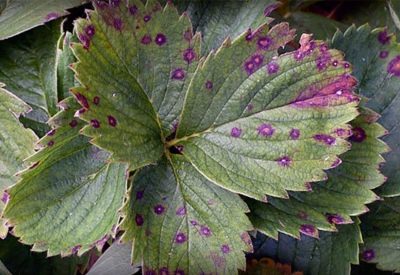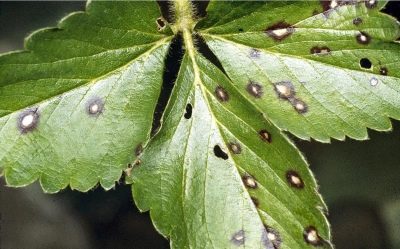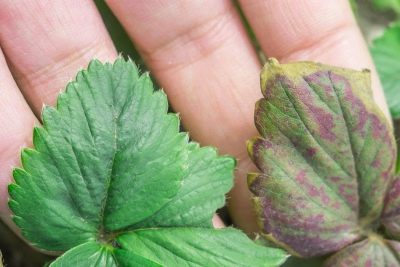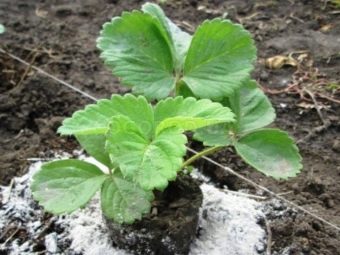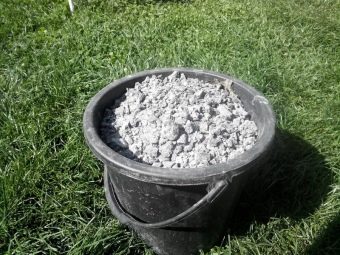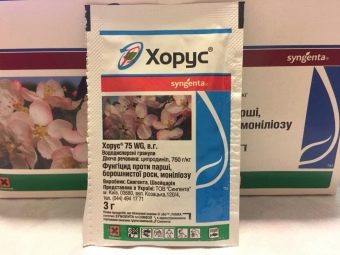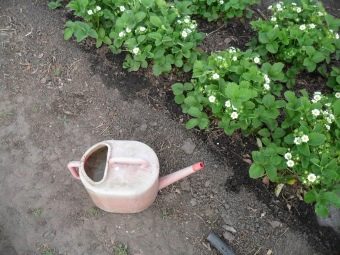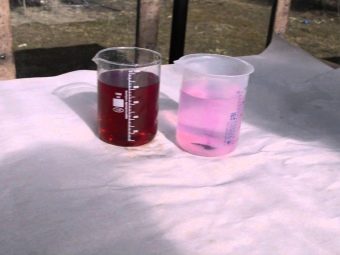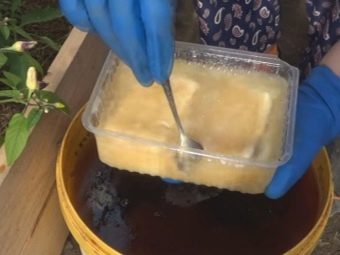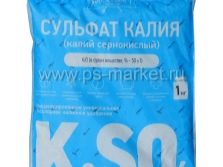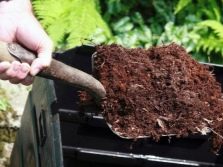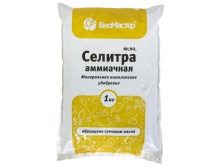Why do strawberry leaves turn red and what to do about it?
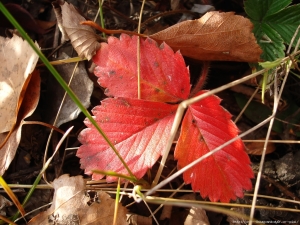
Strawberry is a favorite berry of both children and adults. But how much it requires labor, only those who grow it know.Caring for plants - this is fertilizing, and timely watering, and the fight against various pests and diseases. In this article we will talk a little about the opposition with redness of leaves, which is a manifestation of the disease (various spots).
Causes of the phenomenon
Only in the fall, strawberries, like many plants, at the call of nature, are replaced by an emerald outfit of purple and gold. This is a natural process, and there is nothing to fear. At other times of the year, red spots on the green leaves of your pet are the first sign of a blotchiness.
There are several types of this disease.
- White or ramulariasis (scientific name). When infested with this species, the foliage is covered with white bloom, the spots themselves, increasing, lighten, but retain the red or brown border. With a large area of damage to plantings, you can miss up to 35-50% of the leaves, which will negatively affect the quantity and quality of the harvest (decreases the surface area of greenery involved in photosynthesis). The first signs may appear in the middle of the last month of spring, the peak of flowering - in June (at the end of fruiting). The disease widens the area of its defeat with conidia (white patches on the spots). The incubation period is from 17 to 24 days. One of the factors contributing to the emergence and development of this dirty trick is the increased humidity and heat.
And also noticed that on clay soil with excess content of humus, it is more common. In soil, spores can remain alive for up to 8 years.
- Brown. In this disease, the spots are often brown and also with a rim well visible on the back of the leaf, but with an increase they do not turn white and are located closer to the edge of the leaves. The second name of this scourge is angular spotting. It is dangerous in that it infects plants at the end of summer, at a time when our pet starts tying flower stalks for the next season, and at the beginning of autumn, the diseased leaves dry out. Be careful not to be confused with natural autumn wilting.
- Brown. It causes the appearance of brown and red-brown spots of the same intensity. If the white and brown spots mainly affect only the leaves, then the brown one moves over the whiskers and the plant stems. That it is the main cause of the first redness, and then the drying of the foliage of strawberries, and eventually leads to the death of the bush. Another difference is that it is in a hurry to manifest itself in all its glory, and even before your beautiful strawberry blooms, you may notice its signs, most likely already secondary infections. According to some summer residents, the primary defeat occurred in the previous season in the fruit formation phase, and by August it will hit the whole plant. At the same time on the back side of the sheet a black “down” is formed - ripened pathogen spores.
With widespread distribution, it can infect from 60 to 100% of foliage.
When verticillosis fungus affects the root system, so when flowering and fruit formation, the plant lacks nutrients and this affects the leaves - at first they become sluggish, then turn red and gradually fade. This disease arises from oversaturation of soil moisture. The first manifestations can be seen in the period of blooming flowers, setting strawberry fruit. And it is also possible the appearance of red leaves in strawberries due to the increased acidity of the soil, lack of phosphorus, nitrogen or potassium. But plants grown on sour soil do not dry.
Prevention
Of course, in any case, it is better to prevent redness of the foliage than to fight the disease. If you plant purchased seedlings, purchase them only in proven nurseries or specialized stores - they monitor the quality of their seedlings, as their reputation directly depends on this. Do not buy strawberry bushes with hands - the risk of acquiring fakes or diseased plants is not worth the saved rubles. It is necessary to process the purchase roots with a weak solution of “potassium permanganate”.And the leaves should be washed for a quarter of an hour with hot water (temperature of about +45 degrees Celsius).
Carefully select a place for future beds. Basically, strawberries are unpretentious to the ground (except for the remontant), but on the soil that is too poor in nutrients you will most likely get a shallow, tasteless berry. If the earth is acidic, it is poor in phosphorus - one of the most important elements required by the plant for normal growth and development. But the process of its assimilation is also associated with a sufficient content of nitrogen in the soil.
Before planting, the soil should be treated with a solution of ash and nitrogen fertilizers.
And also remember that the transmission of infections usually occurs with the help of wind and water. It is necessary to try to raise the strawberry beds 50–70 cm above the rest of the plantations. It is necessary to organize the correct watering of your favorite beauty-nurse, while monitoring the temperature of the water. Do not forget about adequate drainage beds. It should be remembered that strawberry is a two-, maximum four-year culture. Do not forget to change the landing sites, while respecting the rules of crop rotation. It is best to plant strawberries after alfalfa, clover and other perennial herbs.
There is no need to make planting too frequent - thickening leads to a more rapid depletion of the soil, and increases the risk of spreading various infections, as well as insect pests. For the prevention of fungal diseases in early spring it is worth spraying bushes Bordeaux liquid, because all spots, like verticillis, are caused by phytopathogenic fungi. The second treatment is carried out after the end of the fruiting season. Bordeaux liquid can be replaced with an ammonia solution with the addition of potassium permanganate and brilliant green (in common parlance - “potassium permanganate” and “green stuff”), if no signs of infection have been found.
Many summer residents use the phytoncide "Horus". For the initial spring treatment, 12 g per 10 l of water is enough, and the second time, after harvesting, the solution is twice as weak. To prevent verticillary wilt, the rules of crop rotation should be carefully observed, because the pathogen in the ground remains viable for 6 years.
Treatment
At the first signs of the disease is to immediately treat the plant. Do not leave infected plants in the garden. If there is suspicion of spotting - remove reddened leaves. If this verticillary wilting, it is necessary to remove the entire bush, then burn. Do not be sorry for one or two torn plants - it will save the rest. You should cut off the antennae and forget about the reproduction of your pet this season - most likely you will get sick seedlings.
The main thing - it is warning spraying the soil. Unfortunately, in the period of flowering and fruit formation strawberries should not be treated with chemicals, because toxic substances accumulate in the berries. Therefore, for the most part, treatment comes down to preventive treatments of the earth in spring and autumn with preparations containing copper. As they are used drugs "Topaz", "Scor", "Zircon" and Bordeaux mixture. "Fitosporin" can be used several times per season, because it is considered quite safe.
There are popular ways of dealing with spotting. The first is the already mentioned “potassium permanganate”. And here is the second eco-friendly composition: mix 30–40 g of any soap (naturally, crushed into chips), 20 g of ordinary soda, 30–50 g of iodine. The resulting mixture should be shaken in a bucket of water. Processing is performed in the phase of affected lower leaves. If the culprit of the ugliness on your strawberry bed is a fungus from the Verticillium family, you are out of luck.
At the initial stages of the development of the disease, treatment with fungicides can help, but if the disease is missed, then the strawberries will die. We'll have to plant new seedlings, and not in the old place.
If the foliage of strawberries turned red due to the “hunger” - the insufficient content of the most important macronutrients - most likely, it can be revived in the current season. But this does not mean that you should give up and do nothing. Need feeding, and better integrated, combining and mineral and organic components. They can be made with your own hands: take 1/3 of a bucket of humus and 5 g of potassium-containing fertilizers (for example, potassium nitrate will do). Mix them in a large container, pour 7-8 liters of water and leave for three days. The dressing prepared in this way must be diluted: 1/10 of fertilizer with 9/10 of water. It should be watered with care - in no case should splash on the leaves and petioles.
If you can, it is worth ordering a soil analysis, then you will know for sure what your sweet nurse is missing. If there is a shortage of nitrogen in the soil, nitrogenous or complex “vitamins of the earth” (ammonium nitrate, nitrogenphos, and others) should be used.
If phosphorus has decided to "walk", it is worth using drugs with a high content of this element (superphosphate and others). And also do not interfere with organic fertilizer - if you use the two-row method of planting bushes, in the gap between the rows should be laid manure. Potassium starvation can be “cured” by feeding the plants with potassium-containing compounds.
What to do if the strawberry leaves turn red, see below.

